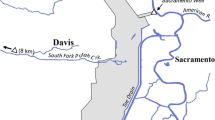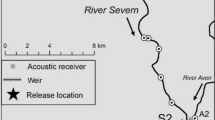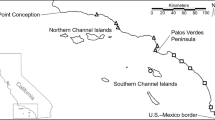Abstract
We used acoustic telemetry to study the post-spawn movement of Oncorhynchus mykiss kelts released in April 2005 and 2006 from the Coleman National Fish Hatchery, Anderson, CA. Following release, O. mykiss kelts demonstrated both anadromous and non-anadromous life histories, with some fish alternating life history strategies between years. Anadromy was most common, characterized by a short-term residence near the release site, followed by sustained downstream emigration once initiated. O. mykiss kelts demonstrating anadromy arrived at the Golden Gate Bridge from April to mid-July. Repeat spawning migrations of anadromous O. mykiss kelts began from late-September through October of the year of release. High fidelity back to Battle Creek was observed, occurring from late-September through November. While most O. mykiss kelts were anadromous, at least 10 % remained in freshwater, or residualized. O. mykiss kelts that residualized demonstrated two distinct patterns of movement: 1) residency near the release location, and 2) potamodromy. Overall survival was high with 36 % and 48 % of O. mykiss kelts released making a repeat spawning migration and demonstrating iteroparity in 2005 and 2006, respectively. Increase in body lengths of O. mykiss kelts that returned to the Coleman NFH were significantly greater for anadromous fish, compared to fish that residualized, but survival was higher for fish that residualized. Release of hatchery O. mykiss kelts could result in both positive and negative genetic and ecological effects to hatchery- and naturally-producing salmonids. We believe the benefits of releasing O. mykiss kelts at the Coleman NFH, including increased numbers and size of fish in the recreational fishery and genetic and demographic benefits to the hatchery brood stock outweigh the limited risk to natural populations that would result from predation and competition of the relatively small number of O. mykiss kelts that resided in fresh water.



Similar content being viewed by others
References
Araki H, Ardren WR, Olsen E, Cooper B, Blouin MS (2007a) Reproductive success of captive-bred steelhead trout in the wild: evaluation of three hatchery programs in the hood river. Conserv Biol 21(1):181–190
Araki H, Waples RS, Ardren WR, Cooper B, Blouin MS (2007b) Effective population size of steelhead trout: influence of variance in reproductive success, hatchery programs, and genetic compensation between life-history forms. Mol Ecol 16(5):953–966
Bagenal TB (1969) Relationship between egg size and fry survival in brown trouth, Salmo trutta L. J Fish Biol 1:349–353
Barnhart RA (1986) Species profiles: life histories and environmental requirements of coastal fishes and invertebrates (Pacific Southwest)—steelhead. USFWS Biol Rep 82(11.60). US Army Corps of Engineers, TR EL–82–4. p 21
Beacham TD, Withler RE, Murray CB, Barner LW (1988) Variation in body size, morphology, egg size, and biochemical genetics of pink salmon in British Columbia. Trans Am Fish Soc 117:109–126
Boyce NPJ (1974) Biology of Eubothrium salvelini (Cestoda: Pseudophyllidea), a parasite of juvenile sockey salmon (Oncorhynchus nerka) of Babine Lake, British Columbia. J Fish Res Board Can 31:1735–1742
Brown ME (1946) The growth of brown trout (Salmon trutta Linn): factors influencing the growth of trout fry. J Exp Biol 22:118–129
Burgner RL, Light JT, Margolis L, Okazaki T, Tautz A, Ito S (1992) Distribution and origins of Steelhead Trout (Oncorhynchus mykiss) in offshore waters of the North Pacific Ocean International North Pacific Fisheries Commission. Bulletin 51:1–92
Busby PJ, Wainwright TC, Bryant GJ, Lierheimer LJ, Waples RS, Waknitz FW, Lagomarsino IV (1996) Status review of west coast steelhead from Washington, Idaho, Oregon, and California. US Department of Commerce, NOAA technical memo. NMFS–NWFSC–27
Christie MR, Marine ML, Blouin MS (2011) Who are the missing parents? Grandparentage analysis identifies multiple sources of gene flow into a wild population. Mol Ecol 20(6):1263–1276
Crespi BJ, Teo R (2002) Comparative phylogenetic analysis of the evolution of semelparity and life history in salmonid fishes. Evolution 56:1008–1020
Fleming IA (1996) Reproductive stragies of Atlantic salmon: ecology and evolution. Rev Fish Biol Fish 6:379–416
Fleming IA, Gross MR (1994) Breeding competition in a Pacific salmon (coho: Oncorhynchus kisutch): measures of natural and sexual selection. Evolution 48:637–657
Fleming IA, Reynolds JD (2004) Salmon breeding systems. In: Hendry AP, Stearns SC (eds) Evolution illuminated: salmon and their relatives. Oxford University Press, Oxford, pp 264–294
Fowler LG (1972) Growth and mortality of fingerling Chinook salmon as affected by egg size. Prog Fish Cult 34:66–69
Glebe BD, Appy TD, Saunders RI (1979) Genetic factors in sexual maturity of cultured Atlantic Salmon (Salmo salar) parr and adults reared in sea cages. Can Spec Publ Fish Aquat Sci 89:24–29
Hallock RJ (1989) Upper Sacramento River steelhead, Oncorhynchus mykiss, 1952–1988. Report to U.S. Fish and Wildlife Service. pp 86
Hatchery Scientific Review Group (HSRG), Mobrand L, Barr J, Blankenship Lee, Campton D, Evelyn T, Flagg T, Mahnken C, Piper R, Seidel P, Seeb L, and Smoker B (2004) Hatchery reform: principles and recommendations of the HSRG. Long Live the Kings, 1305 Fourth Avenue, Suite 810, Seattle, WA 98101 (available from www.hatcheryreform.org)
Heath DD, Bettles CM, Jamieson S, Stasiak I, Docker MF (2008) Genetic differentiation among sympatric migratory and resident life history forms of rainbow trout in British Columbia. Trans Am Fish Soc 137(4):1268–1277
Hutchings JA (1991) Fitness consequences of variation in egg size and food abundance in brook trout, Salvelinus fontinalis. Evolution 45:1162–1168
Jonsson N, Hansen LP, Jonsson B (1991) Variation in age, size and repeat spawning of adult Atlantic salmon in relation to river discharge. J Anim Ecol 60:937–947
Keefer ML, Werheimer RH, Allen AF, Boggs CT, Peery CA (2008) Iteroparity in Columbia River summer-run steelhead (Oncorhynchus mykiss): implications for conservation. Can J Fish Aquat Sci 65(12):2592–2605
Kostow KE (2009) Factors that contribute to the ecological risks of salmon and steelhead hatchery programs and some mitigating strategies. Rev Fish Biol Fish 19:9–31
Lohr SC, Bryant MD (1999) Biological characteristics and population structure of steelhead (Oncorhynchus mykiss) in Southeast Alaska. United States Forest Service Technical Report PNW-GTR-407. U.S. Department of Agriculture, Forest Service, Pacific Northwest Research Station, Portland, OR, p 29. Available at http://www.fs.fed.us/pnw/pubs/pnw_gtr407.pdf
McMichael GA, Sharpe CS, Pearsons TN (1997) Effects of residual hatchery-reared steelhead on growth of wild rainbow trout and spring Chinook salmon. Trans Am Fish Soc 126:230–239
Neave F (1944) Racial characteristics and migratory habits in Salmo gairdneri. J Fish Res Board Can 6:245–251
Nielsen JL, Turner SM, Zimmerman CE (2011) Electronic tags and genetics explore variation in migrating steelhead kelts, Ninilchik River, Alaska. Can J Fish Aquat Sci 68(1):1–16
Niemela E, Erkinaro J, Julkunen M, Hassinen E, Lansman M, Brors S (2006) Temporal variation in abundance, return rate and life histories of previously spawned Atlantic salmon in a large subarctic river. Jour Fish Biol 68:1222–1240
Parker RR (1971) Size selective predation among juvenile salmonid fishes in a British Columbia inlet. J Fish Res Board Can 28:1503–1510
Patten BG (1977) Body size and learned avoidance as factors affecting predation on coho salmon, Oncorhynchus kisutch, fry by torrent sculpin, Cottus rhotheus. Fish Bull US 75:457–459
Pavlov DS, Savvaitova KA, Kuzishchin KV, Gruzdeva MA, Mal’tsev AY, Stanford JA (2008) Diversity of life strategies and population structure of Kamchatka mykiss Parasalmo mykiss in the ecosystems of small salmon rivers of various types. J Ichthy/Voprosy Ikhtiologii 48:42–49
Quinn TP (2005) The behavior and ecology of Pacific salmon and trout. Am Fish Soc, Bethesda, Md
Quinn TP, Seamons TR, Vollestad LA, Duffy E (2011) Effects of growth and reproductive history on the egg size-fecundity trade-off in steelhead. Trans Am Fish Soc 140(1):45–51
Shapovalov L, Taft AC (1954) The life histories of the steelhead rainbow trout (Salmo gairdneri gairdneri) and silver salmon (Oncorhynchus kisutch) with special reference to Waddell Creek, California, and recommendations regarding their management. Calif Dep Fish Game Fish Bull 98:375
Steward CR, Bjornn TC (1990) Supplementation of salmon and steelhead stocks with hatchery fish: a synthesis of published literature. Idaho Cooperative Fisheries and Wildlife Research Unit, Univ. of Idaho, Moscow, ID, Tech. Report 901
Taylor EB, McPhail JD (1985) Burst swimming and size-related predation of newly emerged coho salmon Oncorhynchus kisutch. Trans Am Fish Soc 114:546–551
Teo SLH, Sandstom PT, Chapman ED, Null RE, Brown K, Klimley AP, Block BA (2011) Archival and acoustic tags reveal the post-spawning migrations, diving behavior, and thermal habitat of hatchery-origin Sacramento River steelhead kelts (Oncorhynchus mykiss). Environ Biol Fish. doi:10.1007/s10641-011-9938-4
Thorpe JE, Miles MS, Keay DS (1984) Developmental rate, fecundity and egg size in Atlantic salmon, Salmo salar. Aquaculture 43:289–305
Wankowski JWJ, Thorpe JE (1979) Spatial distribution and feeding in Atlantic salmon, Salmo salar L. juveniles. J Fish Biol 14:239–247
Welch DW, Batten SD, Ward BR (2007) Growth, survival, and tag retention of steelhead trout (O-mykiss) surgically implanted with dummy acoustic tags. Hydrobiologia 582:289–299
Wilbur HM, Rudolf HW (2006) Life-history evolution in uncertain environments: bet hedging in time. Am Nat 168:398–411
Zimmerman CE, Reeves GH (2000) Population structure of sympatric anadromous and non-anadromous Oncorhynchus mykiss: evidence from spawning surveys and otolith microchemistry. Can J Fish Aquat Sci 57:2152–2162
Zimmerman CE, Edwards GW, Perry K (2009) Maternal origin and migratory history of Oncorhynchus mykiss captured in rivers of the Central Valley, California. Trans Am Fish Soc 138:280–291
Acknowledgments
We sincerely appreciate the efforts and cooperation of P. Klimley, B. McFarlane, J. Kelly, J. Heublein, A. Ammann, S. Lindley, and P. Sandstrom who allowed us to utilize data collected from the vast telemetry array that they had in place, without which, this study would not have been possible. K. Brown was especially helpful and provided expertise during surgical implanting of the ultrasonic transmitters. We appreciate L. Mahoney, S. Austing, and S. Giovannetti for their assistance with data analysis and review. Two anonymous reviewers provided comments which improved this manuscript. In addition, C. Brownfield, K. Offill, M. Ricketts, J. Warden, J. Shoemaker, and W. McKinney provided assistance with field operations. Staff at the Coleman NFH were extremely helpful. The findings and conclusions in this article are those of the authors and do not necessarily represent the views of the U.S. Fish and Wildlife Service.
Author information
Authors and Affiliations
Corresponding author
Rights and permissions
About this article
Cite this article
Null, R.E., Niemela, K.S. & Hamelberg, S.F. Post-spawn migrations of hatchery-origin Oncorhynchus mykiss kelts in the Central Valley of California. Environ Biol Fish 96, 341–353 (2013). https://doi.org/10.1007/s10641-012-0075-5
Received:
Accepted:
Published:
Issue Date:
DOI: https://doi.org/10.1007/s10641-012-0075-5




